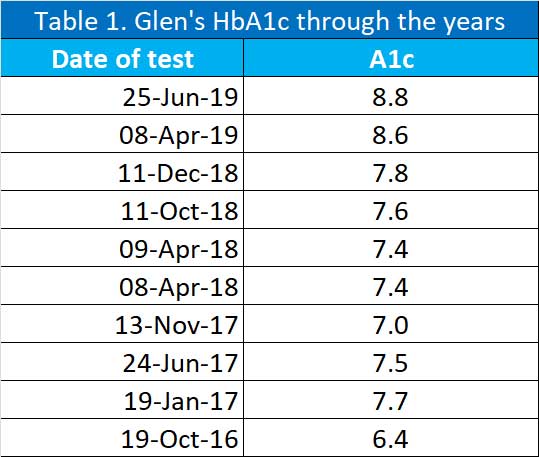28th September 2019. Dr Chee L Khoo
I have known Greg for about 30 years. He is now 63 years old and has amongst many medical conditions, type 2 diabetes (T2D). He is a working class telephony technician. I have seen him and his children grown up. They are now adult kids but Greg, like the usual middle aged Australian, has gradually grown fatter and less healthy over the years. Despite all my diligence, we failed to stem the tide. So, the metabolic elements with obesity gradually pile up over the years – hypertension, dyslipidaemia, fatty liver, borderline high glucose, kidney stones and reflux oesophagitis. By 2005, his BMI had reached 34. He now has depression and arthritis as well. Sugars have been borderline (“prediabetes”) for years but he was not a diabetic yet. It was just a matter time.
He underwent a right nephrectomy in 2008 for renal cell carcinoma. He went through with flying colours as they all do with renal cancer at this age. Unfortunately, he developed an incisional hernia in 2014 which needed laparoscopic repair with mesh reinforcement. Post-operative recovery was tumultuous – missed bowel perforation during laparoscopy, sepsis, pulmonary embolism and wound infection and then wound dehiscence. Over the next few years, he underwent numerous operations to rectify the colostomy, adhesions and disastrous abdominal wounds.
Of course, exercise and diet were all over the place with his immobility and being in and out of hospitals. With muscle loss and further fat gain, type 2 diabetes began to surface by 2015. By now, he has:
- Hypertension on 3 agents
- Dyslipidaemia on 2 agents
- Sleep apnoea on CPAP
- Gout on allopurinol

- Anti-depressants on SSRI
- Reflux oesophagitis on PPI
- A NOAC for stroke prevention with AF
Metformin was commenced when diabetes was first diagnosed in 2015. A DPP4 inhibitor was added by the 3rd year. An SGLT2 inhibitor was then added when the HbA1c continued to deteriorate. The last HbA1c in June was 8.8 up from 8.6 in April 2019. (see Table 1). We have been through diet and exercise numerous times. We have seen the dietitian. We have seen the exercise physiologist. We even seen the psychologist. Who else can we see to help?
Now there is nothing unusual about this case. T2D is a progressive disease. At diagnosis, there are approximately 50% of beta cells left. On average, it takes about 7-8 years before the rest of the beta cells give up the ghost and we will need insulin therapy. It’s not quite 8 years with Greg but looks like he is there, doesn’t it?
Or should we try him on a GLP1-RA? Should we start him on a basal insulin? Should we start him on a premix? What do we do with the rest of his anti-diabetic medications when we start him on either of the injectable therapy? How do we make those choices?
This case will be one of the “simple” cases we will explore at the Annual DOMTRU GP Diabetes Injectable Masterclass on Sunday, November 10, 2019. Come and join your GP and Allied Health colleagues and share ideas.
